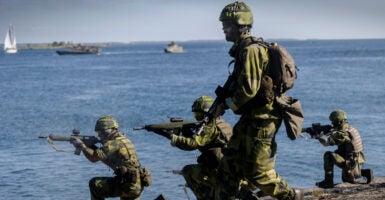The accession of Finland and Sweden to NATO is not just timely, but also transformative.
Sweden and Finland have set the standard for what it means to be a NATO member by investing in their own military capabilities and by taking responsibility for security in Europe.
The United States should be grateful to have two new members of NATO who pull their own weight—in contrast to some legacy NATO members who have failed to meet defense spending goals or to contribute substantial military aid to Ukraine.
The U.S. must also urge other NATO members to do better, allowing the U.S. to focus its resources on the Indo-Pacific region and prioritize countering China’s growing threats and capabilities.
- Sweden has capabilities and strengths from an extensive domestic defense industry and armed forces, which fill a critical gap in NATO capabilities with their ability to operate in the Baltic Sea.
- Finland has capabilities and strength from its manpower and armed forces, which are especially trained and equipped for cold-weather fighting.
Some European countries expect the U.S. to take the lead in providing aid to Ukraine, even though Ukraine is primarily a European security matter. To their credit, Sweden and Finland have shown initiative there, too, and are among the top contributors of military aid to Ukraine.
The Kiel Institute reported that between Jan. 24, 2022, and April 30 of this year, Sweden allocated $2.89 billion in military aid to Ukraine, with Finland not far behind, having allocated $2.18 billion. As part of this aid, both countries have provided Ukraine with weapons, including but not limited to air defense systems, tanks, and munitions.
Critically, Sweden and Finland both meet NATO’s 2% of gross domestic product spending guideline for defense spending.
This year, both Sweden and Finland were active participants in operation Steadfast Defender, an exercise that tested NATO’s defense plan and ability to deploy forces.
Within Steadfast Defender, Sweden and Finland hosted the Nordic Response exercise, with Finland contributing nearly 4,000 troops and Sweden contributing 4,500 troops. And most notably, in June, Sweden and Finland participated in Baltic Operations 2024, the largest recurring NATO naval exercise practicing amphibious operations, gunnery, anti-submarine warfare operations, and air defense.
While that was Sweden’s first time participating as a NATO member, it hosted the exercise on the island of Gotland just two years prior in Baltic Operations 2022, sending a “clear deterrence message” to Russia, according to U.S. Vice Adm. Thomas Ishee.
These actions are more than a display of military commitment and signal a deeper strategic pivot toward enhanced regional cooperation.
As Sweden and Finland cement their positions in NATO, they are already shaping the future of military collaboration within the Baltic nations, Europe, and NATO.
Since joining NATO, Sweden and Finland have demonstrated what it means to be a good member, demonstrating both the will and capacity to contribute to the defense fabric of Europe. By investing in their military capabilities and even going beyond NATO’s 2% defense spending guideline, both countries enhance the alliance in ways that legacy member countries should emulate.
Sweden’s and Finland’s memberships add another layer of deterrence against any temptation by Russia to attempt aggression against a NATO member state.




























